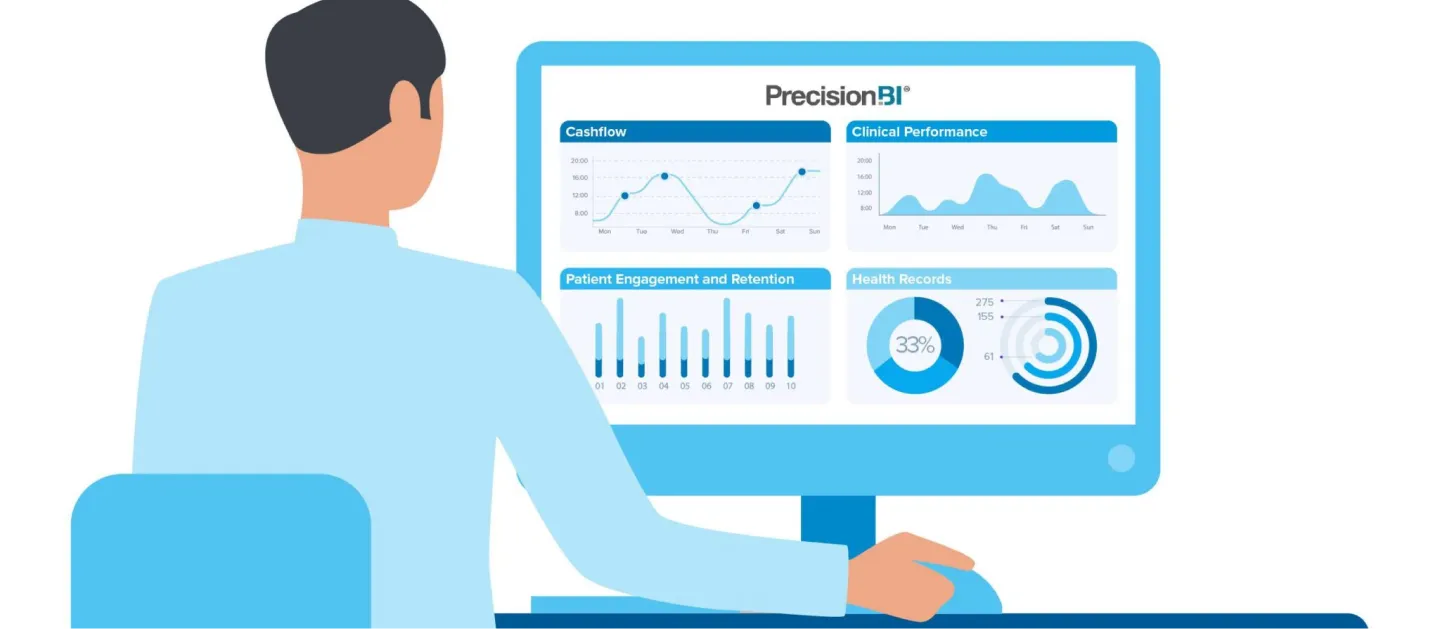Business intelligence (BI) is a term that sounds like an obvious key to success. Of course, we know that BI is an essential element of organizational growth and sustainability, but what does the term ‘business intelligence’ really refer to, and why should you and your medical group be paying attention?
Business Intelligence. Here is why it matters.
The concept of BI has been picking up steam in healthcare, and if you’ve been following along, you know that Business Intelligence has become a standard industry buzzword. In its purest form, business intelligence refers to the technology of data analytics and the solutions it provides in modern-day business operations.
For patient care, insights gathered with BI help direct, high-level decision-making by evaluating practice performance and predicting patient outcome trends. Healthcare organizations produce a lot of data – electronic health records, financial data, and operational data, to name a few.
These broad, complex data categories are often stored separately within practice management systems, making it difficult to access and interpret cohesively. BI changes the game by providing centralized, clean, easy-to-read data visualizations that monitor and track key performance indicators (KPIs) across the entirety of an organization.
To achieve sustainable business growth, implementing BI data analytics in your practice is not optional – it’s essential.
4 Areas where BI can help you get ahead:
- Financial Opportunities
- Clinical Performance
- Patient Outcomes
- Growth Gaps
Financial Opportunities
Healthcare BI is designed to highlight money-saving measures, reduce costs, and build healthier revenue streams while simultaneously delivering the best patient care. From billing to HR and all that falls in between, the specialized analytics that fuel BI have the power to identify and organize KPIs before converting them into readable reports. In turn, you’re able to evaluate and assess the distilled information at a glance to make the best decisions for your organization.
Healthcare waste accounts for $760 Billion.
As of 2019, waste accounted for one-quarter of healthcare spending in the U.S. – to the tune of $760-$935 billion annually. Your practice contributes to that sum, and if you don’t fully understand why or how much, it’s time you found out. Fortunately, discovering your practice’s role in waste contribution can easily be outlined by business intelligence tools. BI’s number one goal is to collect and refine all of your business data and break it down into actionable insights.
You can’t afford to count yourself out of a $760 billion pie – especially when financial waste is highly preventable. With the proper, dedicated BI tools in place to obtain financial data from every corner of your organization, you’ll better ensure your business stays financially strong.
Identify weaknesses in your revenue cycle.
Weaknesses in the revenue cycle management (RCM) process are among the top causes of medical group financial bleed. Unpaid patient statements, incorrectly denied claims, and poor eligibility processes can all negatively impact cashflow.
Because of this, many practices looking to enhance their financial performance start with evaluating RCM. BI analytics are valuable in this effort because of its ability to provide fresh, relevant data on front-end operations like encounter reconciliation, claims billing, claims processing times, outstanding accounts receivable, and payment posting.
Once you’re equipped with the right KPIs, you can analyze the underlying causes of your financial performance and take action to implement cost-saving measures that will boost revenue efficiently and quickly.
Clinical Performance
Using BI to interpret data points within clinical performance provides a litany of ways to optimize your healthcare management. Using real-time updates and customized BI dashboards, you can determine clinical performance gaps, opportunities, and areas for growth and improvement.
These data drivers can be easily identified and used to enhance a number of department processes within your organization.
- Improved Patient Experience
Monitoring and averaging patient wait time enable you to optimize patient satisfaction.
- Optimized Staffing
Coordinate staff scheduling based on patient volumes to prevent staff shortages and enhancing patient care.
- Clinical Enhancements
Generate care plans based on patient symptoms.
- Elevate Clinical Workflows
Ensure accurate and complete clinical documentation to promote clean claim submissions and enhanced revenue cycle management. - Greater Efficiency in Supply Chain Management
Determine inventory lifecycles and optimize inventory reports to choose cost-efficient purchasing options.
Make your data work for you.
Through analytics and visualization tools, BI offers a consolidated view of every data category in your practice, including clinical performance. BI eliminates the need for busy organization leaders and administrative staff to wrestle with traditional data reporting. Instead, it enables the data to do the heavy lifting.
With custom-tailored dashboards providing visual snapshots of your most vital data points, BI gives decision-makers the capability to uncover more insights to confidently execute strategies for improvement.
Patient Outcomes
Only in recent years have patient outcomes become more predictable, and it’s thanks to the kind of healthcare technology that high-performing BI brings to the table.
With BI, patient care can be more closely monitored and improved based on the information practitioners can leverage into each patient’s care plan while remaining compliant with standards and regulations. As BI technology progresses, predictive analytics may fill a larger role in preventing hospital readmissions and epidemics. In effect, the power of data is being harnessed to shift the healthcare focus to preventive measures, rather than solely providing treatment after patients are already ill.
Prioritize patient safety
BI platforms place patient safety at the forefront of healthcare, helping fulfill the medical oath to ‘first do no harm.’
With software that integrates patients’ medical histories and current treatment records, providers are alerted to potential drug duplications and interactions or allergies. In a hospital setting, BI can be tailored to analyze patient data to predict readmission rates, infection rates, and more.
Empower your practitioners
BI can further improve patient outcomes by assisting practitioners in deciphering important patterns around diagnosis, treatment, and ongoing care.
BI platforms can create visual charts and graphs to illustrate forecasted patient outcomes shared across medical teams. Facilitating this kind of transparency between every provider and their support staff promotes stronger collaboration and a higher quality of care.
Repetitive tasks involved in routine follow-ups, patient intake forms, and scheduling can be standardized and automated using BI to alleviate providers’ burden, allowing them more time and resources to focus on the patient.
Engage your patients
Patient-consumers are savvier about their healthcare options than ever before. They want a personalized experience and providers who understand their medical history.
To meet their changing needs and increasing demand for collaborative care, administrators can use BI to make digital patient portals and mobile applications readily available to their patients anytime, anywhere. This allows patients to safely and securely access their personal information.
Leveraging medical technology in this way encourages patients to play a more proactive role in their care or treatment, including making payments and scheduling new appointments. If patients have questions or concerns about a particular aspect of care, patients can use portals to send messages to doctors or nursing staff for efficient, effective communication.
When patients feel empowered in managing their healthcare and are given convenient, accessible tools to do so, more positive patient outcomes naturally follow.
Growth Gaps
You know that growth and profitability are crucial to the long-term success of your business. In order to meet your practice growth goals, it’s important to assess the most up-to-date, relevant data your practice has available. Administrators can use BI tools to gain actionable insights into overall practice performance – helping them identify growth opportunities.
Here are just a few questions medical group leaders can use to determine how they should apply BI to meet their growth goals:
- Do you want to see growth across your entire organization?
BI monitors all organizational data from patient medical histories to accounts receivable to administrative tasks and everything in between. By optimizing each aspect of your business, with the help of value-packed data, you can improve patient satisfaction, ensure providers are well-supported and create a healthy revenue cycle for your practice. - Do you need insights that prove you’re making strong decisions?
The information BI gives administrators and providers allows for fully informed performance audits across departments. With the right data, medical group leaders are given the freedom to innovate and make the best possible decisions for business growth and development. - Do you want to find every opportunity to improve cashflow?
Obtain and compare month-to-month reports to determine what’s been working well and what hasn’t. With the right data, you’ll be ready to strategize your practice management and billing processes based on your unique operational requirements. - Do you want to easily empower your providers with the data they need every day?
From a top-level standpoint, BI gathers the data required to make decisions regarding clinical growth opportunities – like expanding your service offerings or bringing new practitioners onboard to accommodate various patient needs. In an everyday capacity, BI gathers the essential data points necessary to treat patients safely and effectively while complying with industry standards.
Conclusion
Implementing Business Intelligence to enhance practice performance is how innovative medical groups are leveraging technology to further their growth. While many practices have BI elements in their existing practice management software, there’s a significant difference in dedicated, specialized BI that you can custom-fit to your specific practice needs.
In this way, utilizing information technology uncovers insights that enhance patient care and satisfaction, give administrators and providers the support they need, and improve operations and cash flow.
BI is the way of the future, and embracing its wisdom is the right way to ensure sustainability and growth for your practice.




